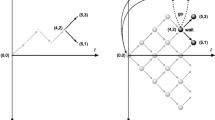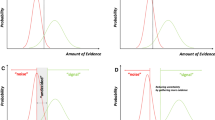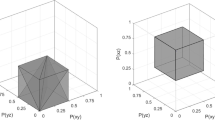Abstract
Influential theories of the decision making process hold that a choice is made once the cumulative weight of noisily sampled information reaches a desired level. While these theories were originally motivated as optimal solutions to statistical problems, the extent to which people optimally spend time deliberating is less well explored. I conduct an experimental test of optimality in a setting where the speed of information processing reflects the difference in value between options. In this case, spending a long time without having arrived at a conclusion signals both that the problem is hard and that the options are similar in value, so the confidence level required to trigger a decision should decline over time. I find that a recently developed theory of the optimal time-varying threshold improves model fit by accurately predicting observed truncation of response time tails. Principles of optimality may thus help account for patterns of choice and response time that characterize the process of deliberation.




Similar content being viewed by others
Notes
While this is the most widely used optimality criterion across fields of study, it is not the only one that has been proposed (for discussion, see Bogacz et al. 2006; Pirrone et al. 2014; and Bhui 2019). Tajima et al. (2016) calculate numerical solutions for collapsing boundaries under alternative criteria such as reward rate maximization, though Pirrone et al. (2018b) fail to find empirical support for the resulting predictions.
Although this setup bears some resemblance to the standard race model due to the specification of two independent accumulators, the two models should not be confused. The race model assumes that a response is triggered when either accumulator crosses a given threshold. The uncertain-difference DDM instead treats the accumulators as two sources of information which are used to inform the optimal balance between reward and time expenditure. Hence, the decision criterion can be defined based on any combination of accumulator values. The setup entails that the difference in accumulators is a sufficient statistic for solving the optimization problem in Expression (2), and thus the uncertain-difference model boils down to a version of the DDM. See also Bogacz et al. (2006) for further explication of the technical connections between various sequential sampling models.
Distinctions between blocks will not be explored in the present analysis since the effects of experience, fatigue, and incentives are confounded.
It must be noted that due to Caltech’s particular nature, all students have strong quantitative backgrounds and are familiar with the normal distribution.
Relatively long response times were also observed in Lam and Kalaska (2014).
Since the properties of the DDM depend only on the ratios between the drift rate, decision threshold, and accumulation noise, one parameter is routinely fixed at some arbitrary level. Typically, this is the noise parameter, but for consistency with the notation of Fudenberg et al. (2018), instead I fix the (conditional) drift rate and allow the accumulation noise to be a free parameter.
In accordance with the experimental design, σ0 was fixed at 7.
There were 10,000 replicates per level of value difference, of which there were approximately 40.
References
Bather, J. A. (1962). Bayes procedures for deciding the sign of a normal mean. Mathematical Proceedings of the Cambridge Philosophical Society, 58(4), 599–620.
Bhui, R. (2019). A statistical test for the optimality of deliberative time allocation. Psychonomic Bulletin & Review. https://doi.org/10.3758/s13423-018-1555-1.
Bitzer, S., Park, H., Blankenburg, F., & Kiebel, S. J. (2014). Perceptual decision making: drift-diffusion model is equivalent to a Bayesian model. Frontiers in Human Neuroscience, 8, 102.
Bode, S., Sewell, D. K., Lilburn, S., Forte, J. D., Smith, P. L., & Stahl, J. (2012). Predicting perceptual decision biases from early brain activity. Journal of Neuroscience, 32(36), 12488–12498.
Bogacz, R., Brown, E., Moehlis, J., Holmes, P., & Cohen, J. D. (2006). The physics of optimal decision making: a formal analysis of models of performance in two-alternative forced-choice tasks. Psychological Review, 113(4), 700–765.
Bollimunta, A., & Ditterich, J. (2012). Local computation of decision-relevant net sensory evidence in parietal cortex. Cerebral Cortex, 22(4), 903–917.
Bollimunta, A., Totten, D., & Ditterich, J. (2012). Neural dynamics of choice: single trial analysis of decision-related activity in parietal cortex. Journal of Neuroscience, 32(37), 12684–12701.
Bowman, N. E., Kording, K. P., & Gottfried, J. A. (2012). Temporal integration of olfactory perceptual evidence in human orbitofrontal cortex. Neuron, 75(5), 916–927.
Britten, K. H., Shadlen, M. N., Newsome, W. T., & Movshon, J. A. (1992). The analysis of visual motion: a comparison of neuronal and psychophysical performance. Journal of Neuroscience, 12(12), 4745–4765.
Brown, S., & Heathcote, A. (2003). QMLE: fast, robust, and efficient estimation of distribution functions based on quantiles. Behavior Research Methods, Instruments, & Computers, 35(4), 485–492.
Brown, J. W., Hanes, D. P., Schall, J. D., & Stuphorn, V. (2008). Relation of frontal eye field activity to saccade initiation during a countermanding task. Experimental Brain Research, 190(2), 135–151.
Churchland, A. K., Kiani, R., & Shadlen, M. N. (2008). Decision-making with multiple alternatives. Nature Neuroscience, 11(6), 693–702.
Cisek, P., Puskas, G. A., & El-Murr, S. (2009). Decisions in changing conditions: the urgency-gating model. Journal of Neuroscience, 29(37), 11560–11571.
Ding, L., & Gold, J. I. (2010). Caudate encodes multiple computations for perceptual decisions. Journal of Neuroscience, 30(47), 15747–15759.
Ding, L., & Gold, J. I. (2012). Separate, causal roles of the caudate in saccadic choice and execution in a perceptual decision task. Neuron, 75(5), 865–874.
Ditterich, J. (2006a). Evidence for time-variant decision making. European Journal of Neuroscience, 24(12), 3628–3641.
Ditterich, J. (2006b). Stochastic models of decisions about motion direction: behavior and physiology. Neural Networks, 19(8), 981–1012.
Drugowitsch, J., Moreno-Bote, R., Churchland, A. K., Shadlen, M. N., & Pouget, A. (2012). The cost of accumulating evidence in perceptual decision making. Journal of Neuroscience, 32(11), 3612–3628.
Fard, P. R., Park, H., Warkentin, A., Kiebel, S. J., & Bitzer, S. (2017). A Bayesian reformulation of the extended drift-diffusion model in perceptual decision making. Frontiers in Computational Neuroscience, 11, 29.
Forstmann, B. U., Dutilh, G., Brown, S., Neumann, J., Von Cramon, D. Y., Ridderinkhof, K. R., & Wagenmakers, E.-J. (2008). Striatum and pre-SMA facilitate decision-making under time pressure. Proceedings of the National Academy of Sciences, 105(45), 17538–17542.
Forstmann, B. U., Anwander, A., Scha¨fer, A., Neumann, J., Brown, S., Wagenmakers, E. J., Bogacz, R., & Turner, R. (2010). Cortico-striatal connections predict control over speed and accuracy in perceptual decision making. Proceedings of the National Academy of Sciences, 107(36), 15916–15920.
Forstmann, B. U., Ratcliff, R., & Wagenmakers, E.-J. (2016). Sequential sampling models in cognitive neuroscience: advantages, applications, and extensions. Annual Review of Psychology, 67, 641–666.
Fudenberg, D., Strack, P., & Strzalecki, T. (2018). Speed, accuracy, and the optimal timing of choices. American Economic Review, 108(12), 3651–3684.
Hanks, T. D., Mazurek, M. E., Kiani, R., Hopp, E., & Shadlen, M. N. (2011). Elapsed decision time affects the weighting of prior probability in a perceptual decision task. Journal of Neuroscience, 31(17), 6339–6352.
Hawkins, G. E., Marley, A., Heathcote, A., Flynn, T. N., Louviere, J. J., & Brown, S. D. (2014). Integrating cognitive process and descriptive models of attitudes and preferences. Cognitive Science, 38(4), 701–735.
Hawkins, G. E., Forstmann, B. U., Wagenmakers, E.-J., Ratcliff, R., & Brown, S. D. (2015). Revisiting the evidence for collapsing boundaries and urgency signals in perceptual decision-making. Journal of Neuroscience, 35(6), 2476–2484.
Heathcote, A., Brown, S., & Mewhort, D. J. (2002). Quantile maximum likelihood estimation of response time distributions. Psychonomic Bulletin & Review, 9(2), 394–401.
Heathcote, A., Brown, S., & Cousineau, D. (2004). QMPE: estimating Lognormal, Wald, and Weibull RT distributions with a parameter-dependent lower bound. Behavior Research Methods, Instruments, & Computers, 36(2), 277–290.
Khodadadi, A., & Townsend, J. T. (2015). On mimicry among sequential sampling models. Journal of Mathematical Psychology, 68, 37–48.
Krajbich, I., & Rangel, A. (2011). Multialternative drift-diffusion model predicts the relationship between visual fixations and choice in value-based decisions. Proceedings of the National Academy of Sciences, 108(33), 13852–13857.
Krajbich, I., Armel, C., & Rangel, A. (2010). Visual fixations and the computation and comparison of value in simple choice. Nature Neuroscience, 13(10), 1292–1298.
Krajbich, I., Lu, D., Camerer, C., & Rangel, A. (2012). The attentional drift-diffusion model extends to simple purchasing decisions. Frontiers in Psychology, 3, 193.
Krajbich, I., Oud, B., & Fehr, E. (2014). Benefits of neuroeconomic modeling: new policy interventions and predictors of preference. American Economic Review, 104(5), 501–506.
Krajbich, I., Hare, T., Bartling, B., Morishima, Y., & Fehr, E. (2015). A common mechanism underlying food choice and social decisions. PLoS Computational Biology, 11(10), e1004371.
Lam, E. and Kalaska, J. F. (2014). Choosing sides: the psychophysics of target choices using random dot kinematograms with mutually contradictory evidence. Unpublished manuscript.
Laming, D. R. J. (1968). Information theory of choice-reaction times. Cambridge: Academic Press.
Milosavljevic, M., Malmaud, J., Huth, A., Koch, C., & Rangel, A. (2010). The drift diffusion model can account for the accuracy and reaction time of value-based choices under high and low time pressure. Judgment and Decision making, 5(6), 437–449.
Moran, R. (2015). Optimal decision making in heterogeneous and biased environments. Psychonomic Bulletin & Review, 22(1), 38–53.
Mullen, K. M., Ardia, D., Gil, D. L., Windover, D., & Cline, J. (2011). DEoptim: an R package for global optimization by differential evolution. Journal of Statistical Software, 40(6), 1–26.
Newsome, W. T., Britten, K. H., & Movshon, J. A. (1989). Neuronal correlates of a perceptual decision. Nature, 341(6237), 52–54.
Niwa, M., & Ditterich, J. (2008). Perceptual decisions between multiple directions of visual motion. Journal of Neuroscience, 28(17), 4435–4445.
O’Connell, R. G., Dockree, P. M., & Kelly, S. P. (2012). A supramodal accumulationto-bound signal that determines perceptual decisions in humans. Nature Neuroscience, 15(12), 1729–1735.
Otter, T., Allenby, G. M., & van Zandt, T. (2008). An integrated model of discrete choice and response time. Journal of Marketing Research, 45(5), 593–607.
Oud, B., Krajbich, I., Miller, K., Cheong, J., Botvinick, M., & Fehr, E. (2016). Irrational time allocation in decision-making. Proceedings of the Royal Society B: Biological Sciences, 283(1822), 20151439.
Palmer, J., Huk, A. C., & Shadlen, M. N. (2005). The effect of stimulus strength on the speed and accuracy of a perceptual decision. Journal of Vision, 5(5), 376–404.
Pirrone, A., Stafford, T., & Marshall, J. A. (2014). When natural selection should optimize speed-accuracy trade-offs. Frontiers in Neuroscience, 8, 73.
Pirrone, A., Azab, H., Hayden, B. Y., Stafford, T., & Marshall, J. A. (2018a). Evidence for the speed–value trade-off: human and monkey decision making is magnitude sensitive. Decision, 5(2), 129–142.
Pirrone, A., Wen, W., & Li, S. (2018b). Single-trial dynamics explain magnitude sensitive decision making. BMC Neuroscience, 19(54), 54.
Ramakrishnan, A., & Murthy, A. (2013). Brain mechanisms controlling decision making and motor planning. Progress in Brain Research, 202, 321–345.
Ramakrishnan, A., Sureshbabu, R., & Murthy, A. (2012). Understanding how the brain changes its mind: microstimulation in the macaque frontal eye field reveals how saccade plans are changed. Journal of Neuroscience, 32(13), 4457–4472.
Rao, R. P. (2010). Decision making under uncertainty: a neural model based on partially observable markov decision processes. Frontiers in Computational Neuroscience, 4, 146.
Ratcliff, R. (1978). A theory of memory retrieval. Psychological Review, 85(2), 59–108.
Ratcliff, R., & McKoon, G. (2008). The diffusion decision model: theory and data for two-choice decision tasks. Neural Computation, 20(4), 873–922.
Ratcliff, R., Philiastides, M. G., & Sajda, P. (2009). Quality of evidence for perceptual decision making is indexed by trial-to-trial variability of the EEG. Proceedings of the National Academy of Sciences, 106(16), 6539–6544.
Ratcliff, R., Smith, P. L., Brown, S. D., & McKoon, G. (2016). Diffusion decision model: current issues and history. Trends in Cognitive Sciences, 20(4), 260–281.
Rigoux, L., Stephan, K. E., Friston, K. J., & Daunizeau, J. (2014). Bayesian model selection for group studies—revisited. NeuroImage, 84, 971–985.
Salinas, E., & Stanford, T. R. (2013). The countermanding task revisited: fast stimulus detection is a key determinant of psychophysical performance. Journal of Neuroscience, 33(13), 5668–5685.
Sanders, A. and Ter Linden, W. (1967). Decision making during paced arrival of probabilistic information. Acta Psychologica, 27, 170–177.
Schall, J. D. (2003). Neural correlates of decision processes: neural and mental chronometry. Current Opinion in Neurobiology, 13(2), 182–186.
Schurger, A., Sitt, J. D., & Dehaene, S. (2012). An accumulator model for spontaneous neural activity prior to self-initiated movement. Proceedings of the National Academy of Sciences, 109(42), E2904–E2913.
Smith, P. L., & McKenzie, C. R. (2011). Diffusive information accumulation by minimal recurrent neural models of decision making. Neural Computation, 23(8), 2000–2031.
Stephan, K. E., Penny, W. D., Daunizeau, J., Moran, R. J., & Friston, K. J. (2009). Bayesian model selection for group studies. NeuroImage, 46(4), 1004–1017.
Stone, M. (1960). Models for choice-reaction time. Psychometrika, 25(3), 251–260.
Tajima, S., Drugowitsch, J., & Pouget, A. (2016). Optimal policy for value-based decisionmaking. Nature Communications, 7(12400), 1–12.
Teodorescu, A. R., Moran, R., & Usher, M. (2016). Absolutely relative or relatively absolute: violations of value invariance in human decision making. Psychonomic Bulletin & Review, 23(1), 22–38.
Thura, D., & Cisek, P. (2014). Deliberation and commitment in the premotor and primary motor cortex during dynamic decision making. Neuron, 81(6), 1401–1416.
Thura, D., Beauregard-Racine, J., Fradet, C.-W., & Cisek, P. (2012). Decision making by urgency gating: theory and experimental support. Journal of Neurophysiology, 108(11), 2912–2930.
Trueblood, J. S., Brown, S. D., & Heathcote, A. (2014). The multiattribute linear ballistic accumulator model of context effects in multialternative choice. Psychological Review, 121(2), 179–205.
Tuerlinckx, F., Maris, E., Ratcliff, R., & De Boeck, P. (2001). A comparison of four methods for simulating the diffusion process. Behavior Research Methods, Instruments, & Computers, 33(4), 443–456.
Usher, M., & McClelland, J. L. (2001). The time course of perceptual choice: the leaky, competing accumulator model. Psychological Review, 108(3), 550–592.
Viviani, P. (1979a). Choice reaction times for temporal numerosity. Journal of Experimental Psychology: Human Perception and Performance, 5(1), 157–167.
Viviani, P. (1979b). A diffusion model for discrimination of temporal numerosity. Journal of Mathematical Psychology, 19(2), 108–136.
Viviani, P., & Terzuolo, C. (1972). On the modeling of the performances of the human brain in a two-choice task involving decoding and memorization of simple visual patterns. Kybernetik, 10(3), 121–137.
Voskuilen, C., Ratcliff, R., & Smith, P. L. (2016). Comparing fixed and collapsing boundary versions of the diffusion model. Journal of Mathematical Psychology, 73, 59–79.
Wald, A. (1947). Sequential analysis. New York: Wiley.
Wang, X.-J. (2002). Probabilistic decision making by slow reverberation in cortical circuits. Neuron, 36(5), 955–968.
Wasserman, L. (2000). Bayesian model selection and model averaging. Journal of Mathematical Psychology, 44(1), 92–107.
Wong, K.-F., & Wang, X.-J. (2006). A recurrent network mechanism of time integration in perceptual decisions. Journal of Neuroscience, 26(4), 1314–1328.
Zhang, S., Lee, M. D., Vandekerckhove, J., Maris, G., & Wagenmakers, E.-J. (2014). Time-varying boundaries for diffusion models of decision making and response time. Frontiers in Psychology, 5, 1364.
Acknowledgements
Thanks to Colin Camerer, Jaron Colas, Taisuke Imai, Ian Krajbich, and Tomasz Strzalecki for helpful comments and discussions. An earlier version of this paper was circulated under the title "Evidence on Optimally Collapsing Thresholds in Value-Linked Decision Making".
Funding
Funding from the Social Sciences and Humanities Research Council of Canada and the Harvard Mind Brain Behavior Interfaculty Initiative is gratefully acknowledged.
Author information
Authors and Affiliations
Corresponding author
Ethics declarations
The experiment was approved by the Caltech Committee for the Protection of Human Subjects.
Additional information
Publisher’s Note
Springer Nature remains neutral with regard to jurisdictional claims in published maps and institutional affiliations.
Electronic Supplementary Material
ESM 1
(PDF 1854 kb)
Rights and permissions
About this article
Cite this article
Bhui, R. Testing Optimal Timing in Value-Linked Decision Making. Comput Brain Behav 2, 85–94 (2019). https://doi.org/10.1007/s42113-019-0025-9
Published:
Issue Date:
DOI: https://doi.org/10.1007/s42113-019-0025-9




